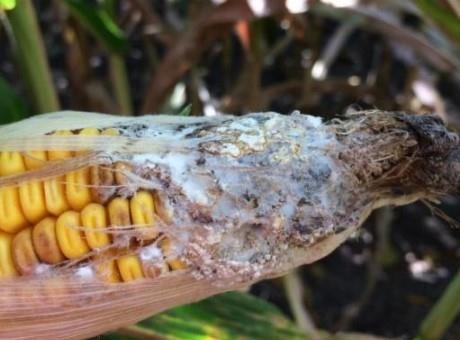But are sap beetles pests of corn?
The answer is a bit complex. Sap beetles are scavengers, typically feeding on decaying plant matter, over-ripe fruit, and plant sap. In corn, sap beetles are almost always a secondary pest, meaning they begin feeding on corn ears only after the ear is already damaged. They typically hollow out kernels, usually at the ear tip.
Most often, sap beetles will colonize corn ears where caterpillars were feeding, such as corn earworm. Because of this, we rarely consider sap beetles to be an economic pest of corn, but its association with other harvest issues can lead to concern. The damage from any ear-feeding insect creates a wound where ear rots and mycotoxins can develop (Photo 2).

If you are experiencing high numbers of sap beetles feeding on ears:
- Consider harvesting those fields early to shorten the time sap beetles are feeding on corn or prevent the development of ear molds prior to harvesting;
- Change combine settings to try to blow out beetles and damaged kernels;
- Monitor grain for the presence of sap beetles, especially if grain will go directly from the field into a grain bin for storage. Insecticide treatments may be necessary to prevent beetles from feeding on stored grain.
- If grain will be dried, make sure to use a high temperature drying operation to kill beetles before storage. Anecdotes from last fall suggest some sap beetles can survive low temperature drying operations.
Sap beetles that are not removed with the crop during harvest will seek sheltered sites (e.g., wooded areas or plant debris) for overwintering soon. Make sure to monitor grain for presence of sap beetles or ear rots prior to storing or marketing.
For subsequent growing seasons, you can reduce the risk of sap beetles a few ways. Consider a corn hybrid with effective Bt traits for corn earworm and other ear-feeding caterpillars to minimize feeding by secondary pests. Additionally, some corn hybrids are more likely to have exposed ear tips than others. Minimize ear tip exposure by choosing a hybrid where the tip of the ear is not as exposed.
Source : iastate.edu